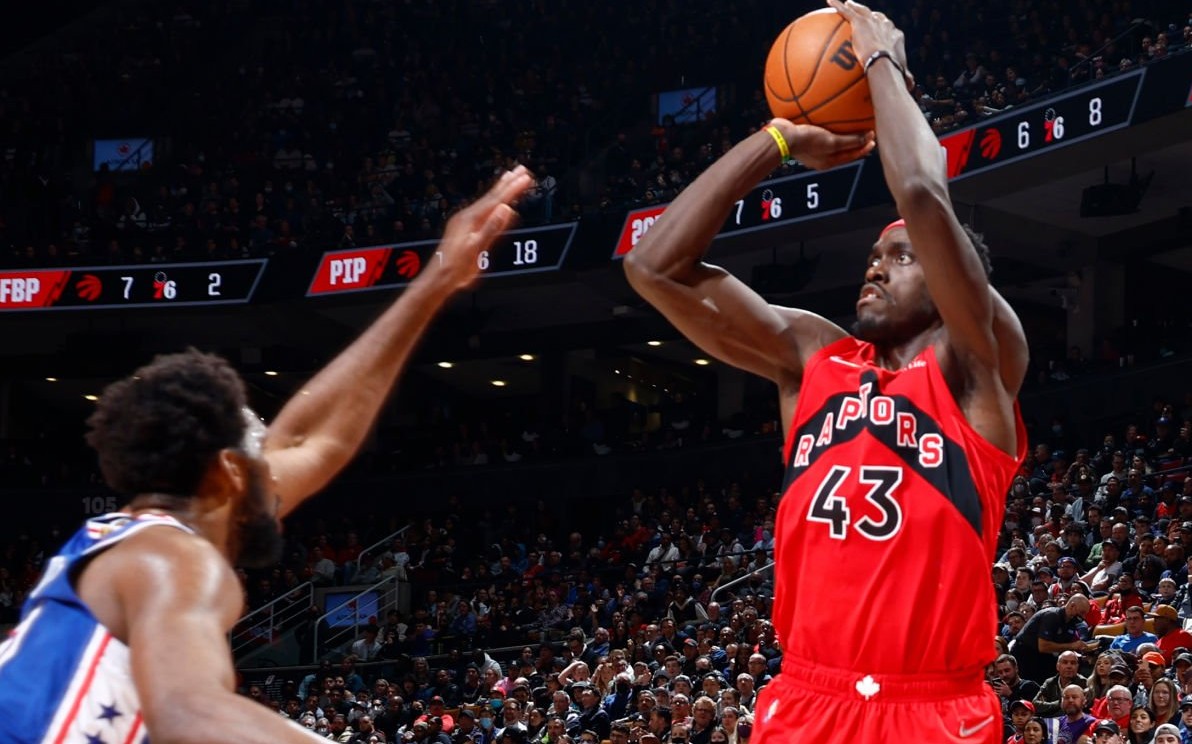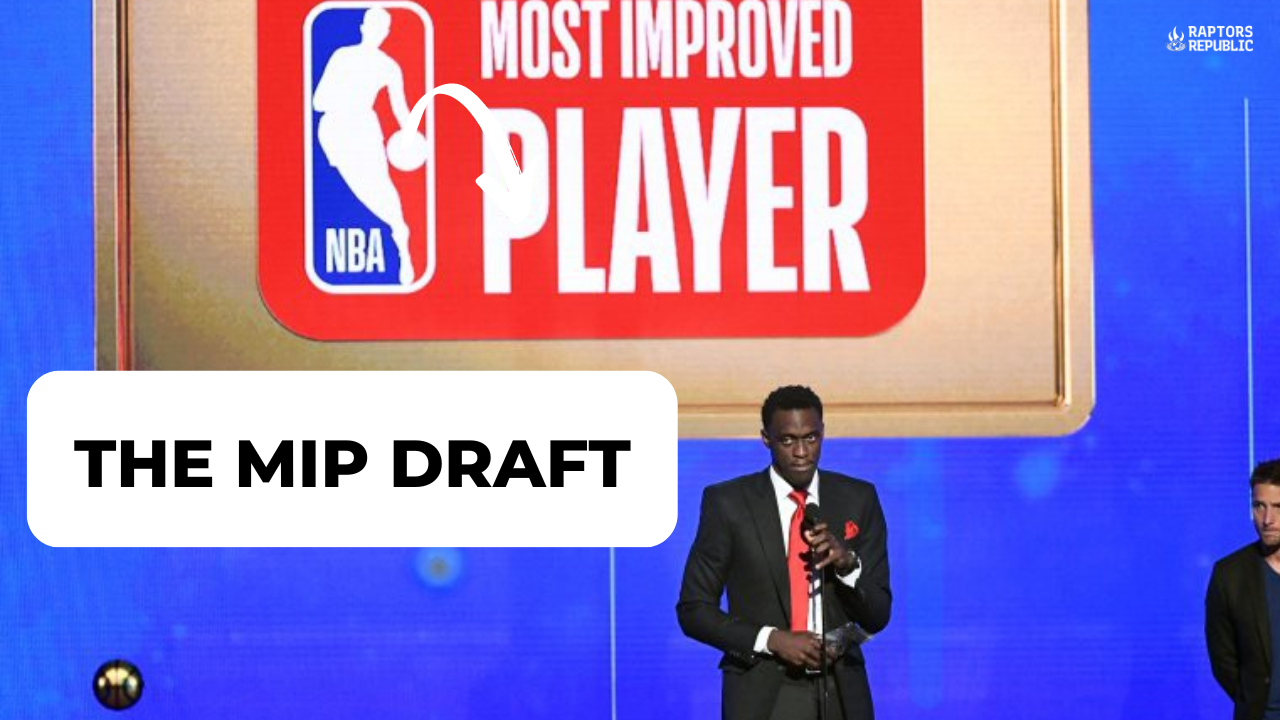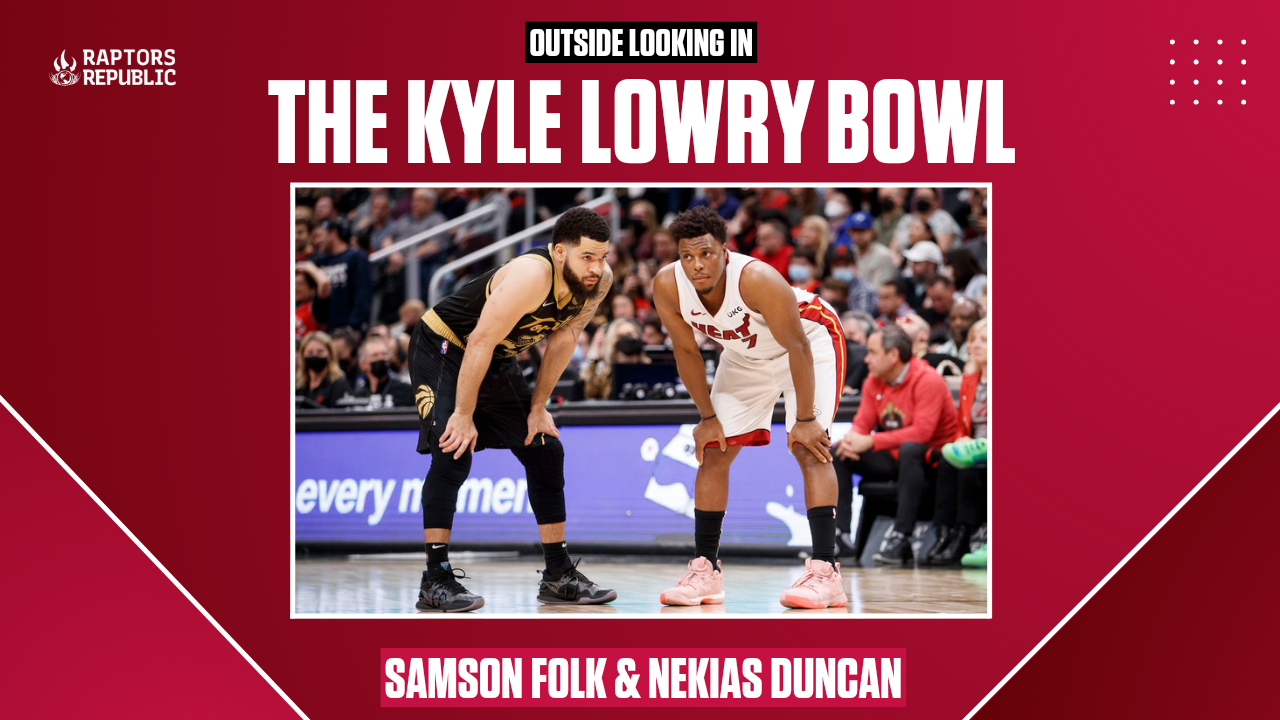The following is a guest post by Simon Broder.
It’s no secret that the 2021-22 Toronto Raptors shot terribly. A middling 112.1 offensive rating, which ranked 15th in the league, understates just how inefficient they were at putting the ball in the basket; thanks to a possession-oriented style that relied heavily on steals and offensive rebounds, the Raptors ranked fourth in the league in field goals attempted but just 27th in effective field goal percentage. You can point the finger at several different culprits for Toronto’s poor half-court offence: the lack of a traditional point guard meant the team ranked near the bottom of the league in assists; the lack of an interior rim threat or elite second-side drivers no doubt contributed to a team which ranked 28th in the league in 2-point percentage; and employing a roster heavily populated with rangy wings who were often spotty outside shooters made it difficult for the team to excel from 3-point range, as evidenced by their below-average numbers in both 3-pt attempts (19th) and efficiency (20th in 3-point percentage).
As the Raptors prepare to bring back a rotation which looks fairly similar to last year’s, it’s fair to wonder if the team can improve in any of these areas. The playmaking will be an area to monitor all season, as the Raptors gradually shifted ballhandling duties last season from Fred VanVleet towards Pascal Siakam and Scottie Barnes, and as Barnes’ usage continues to rise, it’ll be interesting to see if the Raptors can improve their passing numbers or if there will continue to be a lack of emphasis on them. As for interior scoring, there’s no magic elixir; several key rotation players including VanVleet, Gary Trent Jr, OG Anunoby, and Precious Achiuwa notably struggled at the rim last season, and aside from rookie Christian Koloko, the Raptors did not add a significant interior presence this offseason. What they did address was their 3-point shooting. New addition Otto Porter jr. shot 37 percent on 3.4 3-point attempts per game on his way to a championship with the Golden State Warriors last season. But is that addition alone enough to buoy Toronto’s 3-point shooting and help them transform into a competent half-court offence?
Last season’s rotation pieces:
Of Toronto’s nine rotation players who averaged more than 18 minutes per game last season in a reasonable sample size, three were high-volume, above-average shooters (Fred VanVleet, Gary Trent Jr., and OG Anunoby). Three were medium-volume, below-average shooters (Pascal Siakam, Chris Boucher, and Scottie Barnes), and three were relatively low-volume shooters (Precious Achiuwa, Thaddeus Young and Khem Birch).
High-volume, above-average shooters:
Fred VanVleet:
VanVleet’s overall shooting numbers last year are right in line with his career numbers, though he was a much better shooter before the leg injury that plagued his second half (40.1 percent 3-point shooter in his first 50 games vs just 29.1 percent over his final 15 games). Additionally, Freddy was seventh in the league in pull-up 3-point attempts but only shot them at a 33.1-percent clip, as opposed to a 43.3-percent clip on catch-and-shoot threes. It’s not inconceivable that he could see an uptick in his efficiency after an offseason spent healing his leg, and as has been said ad nauseam at this point, he could specifically benefit from running more off-ball as Pascal and Scottie continue to take the reins of the offense and allow him to operate as a floor spacer without the ball in his hands so much.
Gary Trent jr.:
It might surprise you to learn that Trent was the worst Raptors starter last season in eFG%, due largely to his anemic 44.4-percent shooting on 2-pointers. (If you want to know the reason the Raps struggled so much from inside the arc, you don’t need to look much further than that backcourt…ugh). But his 3-point shot has long been his calling card, and his 3-point shooting was solidly above average and right in line with his career numbers. Like Freddy, he could benefit from giving up the ball more when chased off the line rather than trying to force up a contested 2, but his 3-point shooting is essential to keeping this offence afloat (as evidenced by a +5.4 ORtg when he was on the floor) and a big reason why he may continue to start over more well-rounded players going forward.
OG Anunoby:
Not so fun fact: did you know that OG Anunoby was one of the worst players in the league last season as an isolation scorer?
ISO ball is crucial—especially in crunch time, end-of-shot-clock, and playoff settings when defenses lock-in and try to shut off the offensive faucet.
High= ISOs a lot
Low= Rarely ISOs
Left= Extremely Inefficient ISOs
Right= Masterfully Efficient ISOsWHAT STANDS OUT? pic.twitter.com/wfhRrujGL8
— NBA University (@NBA_University) August 25, 2022
Fortunately, he doesn’t usually have to be one on a team that features Barnes and Siakam, and his saving grace offensively is his 3-point shooting: a 36.3-percent mark overall in 2021-22 and 39.6-percent on 5 catch-and-shoot attempts per game, the highest per-game number of attempts on the team and amongst the league leaders. If OG can just stay healthy for a full season – he hasn’t played more than 48 games since 2019-20 – and continue to shoot in line with his career norms, he’ll be a huge key to keeping the Raptors’ 3-point shooting respectable.
Conclusion:
This group kept the Raptors’ 3-point shooting afloat last season, though the shooting percentages of all three players were closer to above average than elite and all three could see those percentages benefit from better role definition and/or health going forward. There is still some room for growth and an overall uptick in productivity, but these weren’t the guys to blame for Toronto’s shooting woes last season.
Medium-volume, below-average shooters:
Pascal Siakam:
Pascal’s 3-point numbers throughout his career are all over the map. He came in as a terrible shooter who almost never attempted a shot outside the arc, then transformed into a solid, high-volume shooter for a couple of seasons before seeing his percentages drop once again. His numbers last year weren’t terrible (34.4 percent from 3 on 3.2 attempts per game), but they weren’t great, either, and at this point Pascal is probably best described as a competent catch-and-shoot option who can keep defenses honest but who shouldn’t be relied on too heavily behind the arc. He’s at his best when he’s only taking threes in the flow of the offense or while on a hot streak, and like many on the team could benefit from being more judicious with his shot selection.
Scottie Barnes:
Ah, the great question: how will Barnes’s shot come along? The star rookie shot just 30.1 percent on 2.6 3-point attempts per game last season, and if he can develop into closer to an average 3-point shooter, it would do a ton to both keep defenses honest and help keep the Raptors’ offense afloat. It’s probably fair to expect some organic improvement here, but the shot was the biggest question mark for Scottie coming into the league and – summer highlights aside – there’s no telling how long the learning curve will be. He can still be a high-level player without the outside shot, but in that case the passing and playmaking really needs to come along. Barnes hitting his triples would be the simplest solution, but it’s probably not one that can be expected.
Chris Boucher:
Like Pascal, Boucher is a tough player to assess when it comes to the outside shot. The shot is objectively ugly, but he was quite proficient in 2020-21 before completely tanking to a 29.7-percent mark from 3 last season. As the season evolved, Boucher found himself a consistent role as a rebounder and hustle player, and he performed wonderfully in it. But unless he can recapture the magic of two seasons ago, he’d probably be better served laying off the threes and letting the professional shooters take them. He and the Raptors found great success doing just that down the stretch.
Conclusion:
Enigmas abound in this group. All three of these guys are lanky power forwards who in years past probably would not have even been asked to spread the floor, but times have changed. There may be some organic improvement here, but all three of these guys should log major minutes next season and will likely continue to be unexceptional shooters, leaving the onus on other players to improve Toronto’s shooting numbers.
Low-volume shooters:
Precious Achiuwa:
It’s probably a little unfair to put Precious Achiuwa in this group. For the season, he shot a solid 35.9 percent on 2.1 3-point attempts per game, but as anyone who was following can tell you, that doesn’t tell the whole story; his attempts and success rate both skyrocketed as the season progressed, culminating in a searing 25-64 (39.1 percent) month of March. Almost all his shots were of the catch-and-shoot variety (144 of 156), so he can hardly be classified as a shot creator, but if he can maintain his percentages from last season while increasing his shot frequency, he could be the stretch center that so many teams desperately crave and a major key to unlocking Toronto’s 3-point potential.. One caveat, though: it remains to be seen whether last year represents his actual true talent level or whether it was just a hot streak for a guy who only had a single 3-point attempt in his rookie season. It was a small sample size.
Thad Young:
Thad Young shot a blistering 39.5 percent from 3 for the Raptors last season but only took 1.7 attempts per game. Over the course of his lengthy career, his 3-point numbers have bounced around quite a bit, but at this stage of his career he probably rates as a league-average or slightly below shooter on low frequency. He knows to limit his attempts mostly to the corners, where he’s by far the most able, shooting 46.7 percent on corner threes with Toronto as compared to 16.7 percent on above-the-break triples. Essentially, he’s embraced a role as an occasional 3-point shooter that Boucher would do well to follow, and while he’ll help Toronto’s spacing going forward, he likely won’t be an impactful source of increased frequency or accuracy.
Khem Birch:
Khem didn’t make a single regular-season three last season, and with the continued development of Achiuwa, other new additions to the roster including Christian Koloko and Porter, and the continuing evolution towards positionless basketball, Khem will likely see his playing time reduced this season. That can only help Toronto’s outside shooting.
Conclusion:
The three players in this group are going in opposite directions. If Precious continues to develop his 3-point shot, he could easily slide into the first group and transform into a key component of Toronto’s improved 3-point offense. On the other hand, with a full season under his belt, Young could slide into a spot in the second group as a below-average, medium-volume shooter; while Birch seems primed to lose his rotation spot altogether. Achiuwa’s growing role and Birch’s diminished role should both help Toronto’s 3-point shooting, and a full season of Young probably wouldn’t hurt, either.
Incoming and outgoing players:
In addition to the regular rotation players listed above, the 2021-22 Raptors also got 249 3-point attempts (at just a 31.3-percent success rate) from Svi Mykhailiuk, Yuta Watanabe, and Armoni Brooks, all of whom have since departed the organization. Two players who are still with the team are Dalano Banton and Malachi Flynn, and if either of the young guards hope to earn regular minutes this season they will no doubt have to improve upon their combined 30.5-percent success rate. Also lurking in the weeds is Justin Champagnie, who should he make the team out of training camp will surely look to validate the solid shooting he showed over a small sample last season.
As far as newcomers go, rookie Christian Koloko likely won’t be asked to take many 3-point shots, but Juancho Hernangomez has proven to be a competent outside shooter on low volume throughout his career, and the team also brought in a couple of guards on two-way deals in Ron Harper jr. and Jeff Dowtin who could potentially provide some shooting punch off the bench.
But the incoming player by far likeliest to have the biggest impact on Toronto’s 3-point shooting is Porter. He comes to the Raptors with a well-earned reputation as a 3-and-D specialist, and his career 39.8-percent mark from outside will undoubtedly help the Raps. But like many of the players on this list, his specialty is catch-and-shoot 3s (196 of his 216 3-point attempts last season were classified as catch-and-shoot), which means that the onus will be on Toronto’s ballhandlers to set him up. His 3.4 attempts per game from last year is right in line with his career average and would slot him in as Toronto’s fourth-most proficient shooter, but it’s still not an especially high-volume. For him to have a major effect on Toronto’s outside shooting, it will have to be amplified by continued growth elsewhere on the roster. There are also availability concerns. Porter has not played in over 70 games since 2017-18, so expecting a full season of productivity may be unrealistic.
So what does it all mean?
The Raptors aren’t an elite 3-point shooting team and probably won’t be one for the foreseeable future. It simply isn’t in their identity as a team that prioritizes rangy, athletic defenders and ballhandlers – players who do all that and can shoot as well are highly coveted, indeed. (Some non-shooting wings do improve, but to expect all of them to become deadly marksmen is unrealistic.) That said, there’s plenty of room for optimism that Toronto can make the incremental improvements across the board required to at least vault themselves in the top half of the league, which if combined with dominating the possession battle, could lead to a lot of success this coming season. In essence, Toronto’s improved 3-point shooting will come down to four things, many of them interconnected: health, internal improvement, better role definition, and improved playmaking/passing.
First of all, Toronto needs its better shooters to stay healthy. Two of Toronto’s best shooters in Anunoby and Porter have struggled to stay on the court in recent seasons, and VanVleet’s injury last season — which really limited his effectiveness — is not guaranteed to be fully resolved right out of the gate. It’s a long shot, but if all three players can log full seasons at maximum effectiveness, it would go a long way towards fixing Toronto’s 3-point concerns
Second, Toronto needs to bank on internal improvement . Achiuwa spent almost half the season as a capable outside shooter and could establish himself in that role going forward. Barnes has been working on his shot all offseason and could see a major jump in both attempts and percentages – and even if he doesn’t, he should see an increased role as a ballhandler who can help create shots. Boucher likely can’t be worse from 3 than he was last year – and if he is, you can bet his leash to take them will get shorter. Pascal’s shot (or shot selection) should continue to improve. At the fringes of the roster are several bench players who could see their usage rise if they can begin to reliably hit some outside shots. And even amongst the high-level shooters, all three of VanVleet, Anunoby and Trent have room to get better.
Third, Toronto will need to focus on role definition. At its heart this comes down to one simple mantra: play to your strengths. Bobby Webster and Masai Ujiri have constructed a roster of players who thrive in catch-and-shoot situations, and going forward it will be important for these players to maximize these opportunities rather than allowing defenders to pressure them into doing things they’re not capable of or good at. This means making quick decisions and good decisions, and a lot of the time it may mean passing the buck if the shot’s not there rather than trying to break down a defender for a contested 2.
Which brings me to my last point: Toronto could need to buy into a more pass-heavy offence. They don’t have to lead the league in assists, but getting back to the middle of the pack should be a priority. The best 3-point shots come out of passes, especially on a team with this many catch-and-shoot specialists. If Toronto can surround one isolation ballhandler capable of drawing the defence into the paint (preferably Siakam or Barnes) with four high-level catch-and-shoot threats at any given time (pick between Anunoby, VanVleet, Trent, Achiuwa, Porter, or even Siakam), and if all five players prove willing and able to make the quick pass when the shot isn’t there, then the Raptors should theoretically be able to get good, high-percentage looks from outside against all but the best defences in the league.



